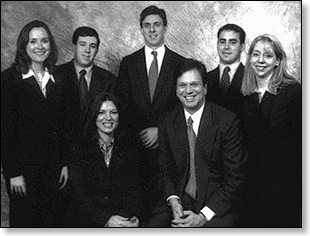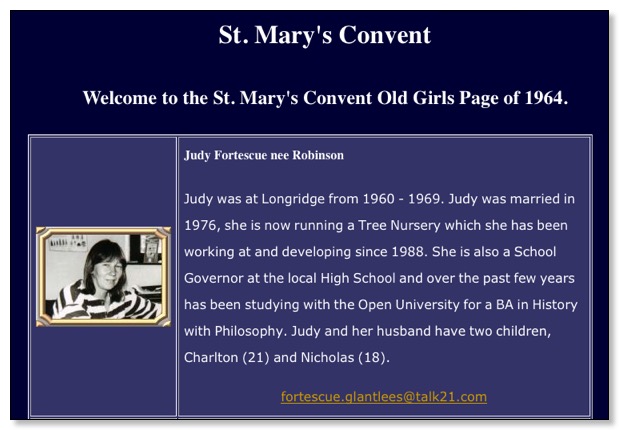James Irvine Fortescue
La famille Fortescue en Angleterre
C'est un fait incontestable que la famille Fortescue en Angleterre et la famille deFortescu en Normandie ont la même origine. Ça ne se débatte point. Selon la forte tradition tenue pendant beaucoup de siècles, l'ancêtre commun de ces deux branches était un certain Richard (ou peut-être Robert) le Fort, un chevalier de forces énormes qui a sauvé la vie du duc Guillaume tombé de son cheval, avec son écu, percé de maintes flèches anglaises à la bataille de Hastings. En l'absences d'archives contemporaines il faut rechercher les témoignages héraldiques. Ceux-ci montrent que les couleurs de la famille étaient argent et azur, la branche normande portant pour écu une bande simple ou bien trois bandes simples et la branche anglaise une bande engrélé indiquant une branche cadette. Par conséquent je déduis au contraire de la tradition anglaise que c'était le fils ainé de Richard le Fort, surnommé deFortescu par le duc Guillaume, à cause de son coup salutaire avec son écu, qui s'est retourné en Normandie pour fonder la famille française et le fils cadet qui a reçu du roi des terres dans le Devonshire en Angleterre.
La devise en latin de la famille Anglaise est Forte Scutum Salus Ducum -- un écu fort est le salut des ducs ou des chefs.
Il parait que le nom du fils cadet était Radulfus Fortescue selon un acte de son petit-fils Richard du onzième siècle. Les preuves écrites de cette époque sont trés rares. Neuf générations après ce dernier Richard, un cadet du seigneur de la famille en Angleterre Sir John Fortescue était nommé gourvernant de Meaux (Seine et Marne) par Henri V d'Angleterre en 1422. Son fils second, Sir John devint Chancellier d'Angleterre sous le roi Henri VI en 1442. Il fut l'ancêtre de Earl Fortescue. Le Earl, c'est à dire Comte, présent est le neufième en descente du premier Earl créé en 1789.
Le premier Fortescue qui s'est établi en Ecosse, mon arrière-grand père Archer Fortescue, fut petit-fils du frère du premier Earl. Il s'est marié en 1848 avec l'héritière d'une propriété qui appartenait à la famille Irvine, race vénérable Ecossaise d'origine du quatorzième siècle, et donc a pris le nom de Irvine-Fortescue.
JAMES IRVINE-FORTESCUE
Juin 2001

Jeanie fortescue
![]()

| Dr Jeanie Fortescue |
![]()


James P. fortescue


The Management

| Michael A. J. Farrell |
Original link : http://www.annaly.com/ns/Annaly/NLYManagement/TheManagement.htm

Jessica Fortescue
http://www.vanityfair.com/contributors/jessica-fortescue
Jessica Fortescue
Archive
Biologique Recherche’s Ambassade de la Beaute
VF.com makes a decadent stop at Biologique Recherche's Ambassade in Paris. Here's our review.
December 8, 2010
By Jessica Fortescue
Maison Francis Kurkdjian Makes Its Debut
Want scented bubbles? Or perfume-quality laundry detergent? Turn to Francis Kurkdjian.
October 30, 2009
By Jessica Fortescue
Les Parfums de Rosine: A Beloved Parisian Import
With a family tradition of fragrance-making going back to Napoleon III, Les Parfums de Rosines Marie Helene Rogeon opens up to Jessica Fortescu about her long love for the brand and the unique history behind it.
May 11, 2009
By Jessica Fortescue
Les Parfums de Rosine: A Beloved Parisian Import
With a family tradition of fragrance-making going back to Napoleon III, Les Parfums de Rosines Marie Helene Rogeon opens up to Jessica Fortescu about her long love for the brand and the unique history behind it.
May 11, 2009
By Jessica Fortescue
Global Spa Roundup: Dior Institut
The spa at the Plaza Athne in Paris.
January 3, 2009
By Jessica Fortescue
Global Spa Roundup: Dior Institut
The spa at the Plaza Athne in Paris.
January 3, 2009
By Jessica Fortescue
![]()


Judy Fortescue


 (2000)
(2000)
The objective of the Group is to deal collectively with all matters affecting the Forest Tree Trade and the Forestry Seed Trade. Representatives liaise with Government on the industry's behalf. Members must first be elected to Membership of the Horticultural Trades Association.
LG & JT Fortescue
Glantlees Trees & Hedging
Newton-on-the Moor, Felton,
Northumberland, NE65 9LR
Tel: 01665-570304 Fax: 01665-570035
Archaeology grants paid in 1995-96 (2000)
Farm Survey
Project Name : Glantlees Farm, Northumberland
Responsible Organisation : Fortescue Mrs J
Plant and Seed Suppliers. (2000)
Glantlees Trees and Hedging.
Low-cost hedging supplies, with details of seed sources.
Judy Fortescue, 'Glantlees', Newton on the Moor, Felton, Northumberland. NE65 9LR.
Tel: 01665-570304; Fax: 01665-570035.
Original link : netcomuk.co.uk
John W. Fortescue (historian)
Chapter Two
The Causes Of The Rebellion
Maj (Retd) AGHA HUMAYUN AMIN from WASHINGTON DC gives a brilliant analysis of the 1857 war of Independence
The events of 1857 were unique both in terms of historical precedence and in terms of the socio-political sphere as far as India was concerned. India as a region has known foreign invaders more frequently than any other region in world history. The reason for it does not lie in the docility or weakness of the Indo-Pak people but in the peculiar geographical position of India by virtue of being bounded in the north by a vast inhospitable and unproductive region which starts from beyond the Indus valley and stretches far north into the steppes of central and eastern Asia. It is an irony of history that the east Asian tribes and races forced the west Asian nomads of Mongol and Turk origin to seek their barbaric design for plunder westwards and these central Asian people repeatedly invaded India. In the process these central and north east Asian nomadic people conquered and colonized China also but also extended their sway in South Asia as well as West Asia.
...
Sir Charles Napier, the Commander-in-Chief of Bengal Army was also convinced that the Bengal Army was the most serious threat to EEIC rule. In 1849 he wrote that it was apparent to him and to all officers on the spot who were conversant with Native and Sepoy habits and feelings, that a widely spread and formidable scheme of mutiny was in progress, and great danger impending 82.'
Whatever historians may state now a cursory glance at the situation in 1857 makes one thing very clear that without the Bengal Army there would have been no rebellion, but this is only one aspect. The other aspect is that without the Bengal Army or for that matter the Madras or the Bombay armies there would have been no EEIC's conquest of India. So the 'Bengal Army Factor' works both ways, it was instrumental in EEIC's success in the first place and it was instrumental in the rebellion also. But the Bengal Army's alienation was a slow process. Mutinies started right from 1757 but these were over administrative, financial and caste matters and not to overthrow EEIC's rule. The transition of rebellion or a bid for independence is always a slow and subtle process. It is in this regard that the British argument that 1857 was just a soldier's mutiny is baseless. The Bengal Army did fight for EEIC for hundred years but by 1857 it was no longer the force that it was in 1757. We will examine the salient aspects which brought this change of perception in the Bengal Sepoy :- (1) The prime motivation of the Bengal Army soldiers in joining the army was economic. Just like the Irishmen of 18th, 19th or 20th centuries. It is true that the British were masters in making other races fight their wars through a subtle system based on regimental pride, motivation, resolute leadership espirit de corps etc. But the essential fact was that the Bengal Sepoy was an Indian and a subject. It is true that the British treated their native soldiers much better than most native soldiers were treated by native rulers. But race is a very rigid barrier and is made more rigid by difference of religion. Man's basic needs are food, water and air, but once these are fulfilled he strives for higher needs and ideals like freedom and independence. The racial barrier which made it impossible for a native to ever be an officer was a major factor in producing alienation. (2) The Bengal Army was composed of 80% Hindu Brahman and Rajputs. Their daily rituals were complicated and conflicted with demands of military life. Slowly and steadily it increased their hatred of their officers and EEIC not because of any personal reason but simply because they belonged to an alien race who they perceived as bent upon damaging their religious sensitivities. Two aspects were important in this regard i.e. travel across sea which was regarded by the high caste Hindus and Rajputs of that time as something which would soil and pollute the purity of their caste. The second was going across the Indus westwards which again in their opinion polluted the purity of their caste. Thus once the First Afghan War started the Bengal Army was deployed west of Indus. This had a serious effect on the morale of the Hindu Brahmans for the reasons : (1) Once the Brahmans crossed the Indus their caste was rendered impure and on return to India they had to spend heavy sums of money on the rituals through which they had to undergo in order to be readmitted to their high caste83. (2) West of Indus they had to eat food which they considered impure and this also soiled their caste. (3) In Afghanistan due to cold climate the Hindus could not carry out the rituals of bathing etc. This was the major reason for the post 1841 rapid decline in the Hindu soldiers morale and not the initial reverses suffered in the First Afghan War. (4) The Muslim troops employed in the First Afghan war were demoralised because they were deployed after a long time against the Muslims. The last time they were deployed against a Muslim state was in 1774 during the Rohilla war. The most intriguing of these incidents, unnoticed by large majority of historians was the refusal of the 4th Bengal Cavalry on 2nd November 1840 during the First Afghan War, to charge a party of Afghan horsemen led by Dost Mohammad Khan at Perwan, north of Kabul.The British historian John Fortescue had no answer for the reason why the 2nd Bengal Light Cavalry fell back and fled from the battle field. Fortescue thus said about this incident that; 'And then followed one of those incidents which after endless explanation remain always mysterious. The 2nd Light Cavalry was a good corps with good officers; but such misconduct could not be overlooked and the regiment was with ignominy disbanded'84. The British did not understand why 2nd Light Cavalry had behaved like that. There was another likely explanation for this behaviour which had a deep connection with 2nd Light Cavalry's history. The 2nd Light Cavalry was raised from Afghans of Kandhari origin settled at Lucknow in 1788 by the Nawab Vizier of Oudh. It became the 2nd Bengal Light Cavalry only in 179685. It is possible that their peculiar Afghan origin may have played a part in their reluctance to charge the Afghans at Perwan!
...
But the introduction of the Greased Cartridges in 1857 was the final and decisive blow. These cartridges which the sepoys thought contained cow or swine's fat was a definite attack on the religion of both Hindus and Muslims. These cartridges gave a simultaneous common ground to both to rationalize their hatred of the EEIC European. The dispersion of British troops and their being outnumbered overwhelmingly in 1857 was the final blow. 'Petty parsimony on part of supreme government in matters of allowances provoked a number of small mutinies in 1843 and 1844.'88 This is the verdict of Sir John Fortescue, the official historian of the British army. Fortescue went further, he noted that 'the same cause amounting to positive injustice brought a number of Bengal Regiments to the verge of revolt in 1849'89. In this case, Sir Charles Napier the Commander-in-Chief of the Company's Bengal Army's confrontation and subsequent resignation was a decisive event. There were two mutinies in the two respective regiments of Bengal Army over stoppage of allowances. Sir Charles Napier disbanded one and restored the allowances for the second. Lord Dalhousie censured him and revoked his orders. Dalhousie was a civilian and a young man. He did not understand the demoralizing effect which this action had on the soldiers of Bengal Army. Sir Charles Napier resigned and went back to Britain in 185090. Sir John Fortescue's opinion on this episode is worth quoting, 'The sepoys thus saw the chief, who had observed equity on their behalf, rewarded by public disgrace'.91
...
Notes and References
43. Page-140 & 428-J.W Fortescue-Op Cit.
84. Page-138- A History of the British Army-Volume-XII-1839-1852-Hon J.W Fortescue-Macmillan and Company Limited, London-1927.
86. Page-230-J.W Fortescue-British Army-Volume-XII Op Cit.
88. Page 238- A History of the British Army-Volume-XIII-1852-1859- Hon J.W Fortescue-Macmillan and Co-London-1930.
91. Pages-234 to 238-J.W Fortescue-Vol-XIII-Op Cit.
